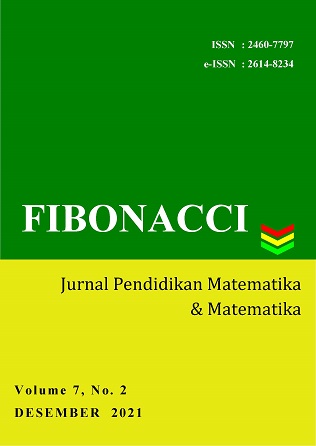FENOMENA LITERASI SPASIAL SISWA: STUDI PADA GEOMETRI RUANG
Main Article Content
Abstract
Article Details
Authors who publish with this journal agree to the following terms:
- Authors retain copyright and grant the journal right of first publication with the work simultaneously licensed under a Creative Commons Attribution License that allows others to share the work with an acknowledgement of the work's authorship and initial publication in this journal.
- Authors are able to enter into separate, additional contractual arrangements for the non-exclusive distribution of the journal's published version of the work (e.g., post it to an institutional repository or publish it in a book), with an acknowledgement of its initial publication in this journal.
- Authors are permitted and encouraged to post their work online (e.g., in institutional repositories or on their website) prior to and during the submission process, as it can lead to productive exchanges, as well as earlier and greater citation of published work (See The Effect of Open Access).
References
Ahmad, & Etmy, D. (2019). Hubungan kemampuan spasial dengan prestasi belajar matematika siswa pada materi mangun ruang sisi datar Kelas VIII Madrasah Tsanawiyah. EL-HIKMAH: Jurnal Pendidikan dan Kajian Keislaman, 12(1), 75–98.
Arai, M. (2018). Aspects of spatial thinking in problem solving: Focusing on viewpoints in constructing internal representations. In P. Herbst, U. H. Cheah, P. R. Richard, & K. Jones (Eds.), International Perspectives on the Teaching and Learning of Geometry in Secondary Schools (pp. 301–317). Switzerland: Springer, Cham. https://doi.org/10.1007/978-3-319-77476-3_17
Arcavi, A. (2003). The role of visual representations in the learning of mathematics. Educational Studies in Mathematics, 52(3), 215–241. https://doi.org/10.1023/A:1024312321077
Battista, M. T. (2007). The development of geometric and spatial thinking. In Second handbook of research on mathematics teaching and learning (Vol. 2, pp. 843–908). Charlotte, NC: NCTM.
Bednarz, S. W., & Kemp, K. (2011). Understanding and nurturing spatial literacy. Procedia - Social and Behavioral Sciences, 21, 18–23. https://doi.org/10.1016/j.sbspro.2011.07.004
Canturk Gunhan, B. (2014). A case study on the investigation of reasoning skills in geometry. South African Journal of Education, 34(2), 1–19. https://doi.org/10.15700/201412071156
Carr, M., Horan, E., Alexeev, N., Barned, N., Wang, L., & Otumfuor, B. (2020). A longitudinal study of spatial skills and number sense development in elementary school children. Journal of Educational Psychology, 112(1), 53–69. https://doi.org/https://doi.org/10.1037/edu0000363
Cheng, K. (2008). Whither geometry? Troubles of the geometric module. Trends in Cognitive Sciences, 12(9), 355–361. https://doi.org/10.1016/j.tics.2008.06.004
Clements, D. H., & Battista, M. T. (1992). Geometry and spatial reasoning. In D. A. Grouws (Ed.), Handbook of research on mathematics teaching and learning (pp. 420–464). New York: NCTM/Macmillan Publishing Co, Inc.
Creswell, J. W. (2012). Educational research: Planning, conducting, and evaluating quantitative and qualitative research (4th ed.). Boston: Pearson Education, Inc. https://doi.org/10.1017/CBO9781107415324.004
Creswell, J. W., & Poth, C. N. (2018). Qualitative inquiry and research design: Choosing among five approaches (4th ed.). Thousand Oaks, California: Sage Publications, Inc. https://doi.org/10.1016/S0022-3476(89)80781-4
De Lange, J. (2003). Mathematics for literacy. In & L. A. S. B. L. Madison (Ed.), Quantitative literacy: Why numeracy matters for schools and colleges (Vol. 80, pp. 75–89). Princeton, NJ: The National Council on Education and the Disciplines.
Diezmann, C., & Lowrie, T. (2009). Primary students’ spatial visualization and spatial orientation: An evidence base for instruction. In Proceedings of the 33rd Conference of the International Group for the Psychology of Mathematics Education (pp. 19–24). Thessaloniki, Greece: PME.
Fiantika, F. R., Maknun, C. L., Budayasa, I. K., & Lukito, A. (2018). Analysis of students’ spatial thinking in geometry: 3D object into 2D representation. Journal of Physics: Conference Series, 1013(1), 12140. https://doi.org/10.1088/1742-6596/1013/1/012140
Gilligan, K. A., Hodgkiss, A., Thomas, M. S. C., & Farran, E. K. (2019). The developmental relations between spatial cognition and mathematics in primary school children. Developmental Science, 22(4), 1–19. https://doi.org/https://doi.org/10.1111/desc.12786
Goldsmith, L. T., Hetland, L., Hoyle, C., & Winner, E. (2016). Visual-spatial thinking in geometry and the visual arts. Psychology of Aesthetics, Creativity, and the Arts, 10(1), 56–71. https://doi.org/https://doi.org/10.1037/aca0000027
Jarvis, C. H. (2011). Spatial literacy and the postgraduate GIS curriculum. Procedia - Social and Behavioral Sciences, 21, 294–299. https://doi.org/10.1016/j.sbspro.2011.07.022
King, H. (2006). Understanding spatial literacy: cognitive and curriculum perspectives. Planet, 17(1), 26–28. https://doi.org/https://doi.org/10.11120/plan.2006.00170026
Korkmaz, H. İ., & Tekin, B. (2020). Investigating preschool teacher candidates’ spatial thinking skills. Kuramsal Eğitimbilim Dergisi, 13(1), 191–204. https://doi.org/https://doi.org/10.30831/akukeg.561847
Kurniawan, A. P., Anam, A. C., Abdussakir, & Rofiki, I. (2019). Integrasi etnomatematika dengan model pembelajaran probing-prompting untuk melatih komunikasi matematis siswa. MaPan: Jurnal Matematika dan Pembelajaran, 7(1), 1–15. https://doi.org/10.24252/mapan.2019v7n1a1
Kusuma, A. B., & Untarti, R. (2018). The identification of the students’ mathematical communication skills error in form of pictures on the geometry of space subject. EDUCARE: International Journal for Educational Studies, 10(2), 87–94.
Merriam, S. B. (1998). Qualitative research and case study applications in education. San Francisco, CA: Jossey-Bass.
Moore-Russo, D., Viglietti, J. M., Chiu, M. M., & Bateman, S. M. (2013). Teachers’ spatial literacy as visualization, reasoning, and communication. Teaching and Teacher Education, 29(1), 97–109. https://doi.org/10.1016/j.tate.2012.08.012
NCTM. (2000). Principles and standards for school mathematics. Reston, VA: National Council of Teachers of Mathematics.
Özerem, A. (2012). Misconceptions in geometry and suggested solutions for seventh grade students. Procedia - Social and Behavioral Sciences, 55, 720–729. https://doi.org/10.1016/j.sbspro.2012.09.557
Rofiki, I. (2013). Profil pemecahan masalah geometri siswa kelas akselerasi SMP Negeri 1 Surabaya ditinjau dari tingkat kemampuan matematika. In Prosiding Seminar Nasional Matematika dan Aplikasinya Departemen Matematika Fakultas Sains dan Teknologi Universitas Airlangga (Vol. 1, pp. 300-310).
Rofiki, I., Nusantara, T., Subanji, & Chandra, T. D. (2017a). Reflective plausible reasoning in solving inequality problem. IOSR Journal of Research & Method in Education (IOSRJRME), 7(1), 101–112. https://doi.org/10.9790/7388-070101101112
Rofiki, I., Nusantara, T., Subanji, & Chandra, T. D. (2017b). Exploring local plausible reasoning: The case of inequality tasks. Journal of Physics: Conference Series, 943(1), 012002. https://doi.org/10.1088/1742-6596/943/1/012002
Stake, R. E. (1995). The art of case study research. Thousand Oaks, California: Sage Publications, Inc.
Yin, R. K. (2014). Case study research: Design and methods (applied social research methods). Thousand Oaks, CA: Sage publications.

